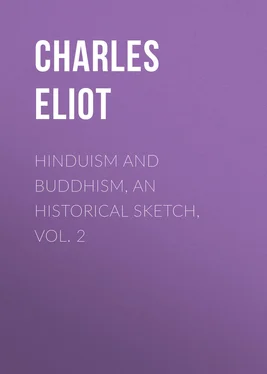These as well as the red colour are attributes of the Hindu deity Brahmâ.
A temple on the north side of the lake in the Imperial City at Peking contains a gigantic image of him which has literally a thousand heads and a thousand hands. This monstrous figure is a warning against an attempt to represent metaphors literally.
Waddell on the Cult of Avalokita, J.R.A.S. 1894, pp. 51 ff. thinks they are not earlier than the fifth century.
See especially Foucher, Iconographie Bouddhique , Paris, 1900.
See especially de Blonay, Études pour servir à l'histoire de la déesse bouddhique Târâ , Paris, 1895. Târâ continued to be worshipped as a Hindu goddess after Buddhism had disappeared and several works were written in her honour. See Raj. Mitra, Search for Sk. MSS . IV. 168, 171, X. 67.
About the time of Hsüan Chuang's travels Sarvajñâmitra wrote a hymn to Târâ which has been preserved and published by de Blonay, 1894.
Chinese Buddhists say Târâ and Kuan-Yin are the same but the difference between them is this. Târâ is an Indian and Lamaist goddess associated with Avalokita and in origin analogous to the Saktis of Tantrism. Kuan-yin is a female form of Avalokita who can assume all shapes. The original Kuan-yin was a male deity: male Kuan-yins are not unknown in China and are said to be the rule in Korea. But Târâ and Kuan-yin may justly be described as the same in so far as they are attempts to embody the idea of divine pity in a Madonna.
But many scholars think that the formula Om manipadme hum, which is supposed to be addressed to Avalokita, is really an invocation to a form of Śakti called Maṇipadmâ. A Nepalese inscription says that "The Śâktas call him Śakti" ( E.R.E. vol. II. p. 260 and J.A. IX. 192), but this may be merely a way of saying that he is identical with the great gods of all sects.
Harlez, Livre des esprits et des immortels , p. 195, and Doré, Recherches sur les superstitions en Chine , pp. 94-138.
See Fenollosa, Epochs of Chinese and Japanese Art I. pp. 105 and 124; Johnston, Buddhist China , 275 ff. Several Chinese deities appear to be of uncertain or varying sex. Thus Chun-ti is sometimes described as a deified Chinese General and sometimes identified with the Indian goddess Marîcî. Yü-ti, generally masculine, is sometimes feminine. See Doré, l.c. 212. Still more strangely the Patriarch Aśvaghosha (Ma Ming) is represented by a female figure. On the other hand the monk Ta Shêng (c. 705 A.D.) is said to have been an incarnation of the female Kuan Yin. Mañjuśrî is said to be worshipped in Nepal sometimes as a male, sometimes as a female. See Bendall and Haraprasad, Nepalese MSS. p. lxvii.
de Blonay, l.c. pp. 48-57.
Chinese, Man-chu-shih-li, or Wên-shu; Japanese, Monju; Tibetan, hJam-pahi-dbyans (pronounced Jam-yang). Mañju is good Sanskrit, but it must be confessed that the name has a Central-Asian ring.
Translated into Chinese 270 A.D.
Chaps. XI. and XIII.
A special work Mañjuśrîvikrîḍita (Nanjio, 184, 185) translated into Chinese 313 A.D. is quoted as describing Mañjuśrî's transformations and exploits.
Hsüan Chuang also relates how he assisted a philosopher called Ch'en-na (=Diṅnâga) and bade him study Mahayanist books.
It is reproduced in Grünwedel's Buddhist Art in India . Translated by Gibson, 1901, p. 200.
Dharmacakramudra.
For the Nepalese legends see S. Levi, Le Nepal , 1905-9.
For an account of this sacred mountain see Edkins, Religion in China , chaps. XVII to XIX.
See I-tsing, trans. Takakusu, 1896, p. 136. For some further remarks on the possible foreign origin of Mañjuśrî see below, chapter on Central Asia. The verses attributed to King Harsha (Nanjio, 1071) praise the reliquaries of China but without details.
Some of the Tantras, e.g. the Mahâcînakramâcâra, though they do not connect Mañjuśrî with China, represent some of their most surprising novelties as having been brought thence by ancient sages like Vasishṭha.
J.R.A.S. new series, XII. 522 and J.A.S.B. 1882, p. 41. The name Manchu perhaps contributed to this belief.
It is described as a Svayambhû or spontaneous manifestation of the Âdi-Buddha.
Sanskrit, Maitreya; Pali, Metteyya; Chinese, Mi-li; Japanese, Miroku; Mongol, Maidari; Tibetan, Byams-pa (pronounced Jampa). For the history of the Maitreya idea see especially Péri, B.E.F.E.O. 1911, pp. 439-457.
But a Siamese inscription of about 1361, possibly influenced by Chinese Mahayanism, speaks of the ten Bodhisattvas headed by Metteyya. See B.E.F.E.O. 1917, No. 2, pp. 30, 31.
E.g. in the Mahâparinibbâna Sûtra.
Dig. Nik. XXVI. 25 and Buddhavamsa, XXVII. 19, and even this last verse is said to be an addition.
See e.g. Watters, Yüan Chwang , I. 239.
See Watters and Péri in B.E.F.E.O. 1911, 439. A temple of Maitreya has been found at Turfan in Central Asia with a Chinese inscription which speaks of him as an active and benevolent deity manifesting himself in many forms.
He has not fared well in Chinese iconography which represents him as an enormously fat smiling monk. In the Liang dynasty there was a monk called Pu-tai (Jap. Hotei) who was regarded as an incarnation of Maitreya and became a popular subject for caricature. It would appear that the Bodhisattva himself has become superseded by this cheerful but undignified incarnation.
The stupa was apparently at Benares but Hsüan Chuang's narrative is not clear and other versions make Râjagṛiha or Srâvasti the scene of the prediction.
Campa. This is his bodhi tree under which he will obtain enlightenment as Sâkyamuni under the Ficus religiosa . Each Buddha has his own special kind of bodhi tree.
Record of the Buddhist religion , Trans. Takakusu, p. 213. See too Watters, Yüan Chwang , II. 57, 144, 210, 215.
Chinese P'u-hsien. See Johnston, From Peking to Mandalay , for an interesting account of Mt. Omei.
Or Mahâsthâna. Chinese, Tai-shih-chih. He appears to be the Arhat Maudgalyâyana deified. In China and Japan there is a marked tendency to regard all Bodhisattvas as ancient worthies who by their vows and virtues have risen to their present high position. But these euhemeristic explanations are common in the Far East and the real origin of the Bodhisattvas may be quite different.
E.g. Watters, I. p. 229, II. 215.
Читать дальше












